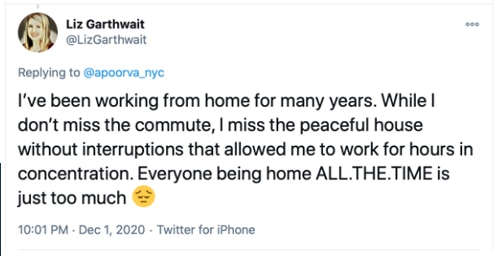BRIGHT SPOT #1: Working from home has come to its senses.
For office workers, the biggest work impact of the COVID-19 pandemic will be the normalization of working from home.
Before the pandemic, the default work site was the office. Nearly one-third—29 percent—of Americans had the option to work from home, and many did. But when they did, office norms applied. You know what that meant.
- It was embarrassing to have dogs bark during business calls.
- Children were sternly admonished for invading your GoToMeeting video call.
- Eating was forbidden.
After 2020, those rules are relaxing.
- Now, colleagues insist on seeing your pets.
- A child in the room (or on your lap) is taken in stride, and may even be endearing.
- If you’re in conferences all day long, eating is OK if you’re listening to colleagues (although your microphone must be muted and do NOT chew while speaking and NEVER eat with clients).

Most of us will agree this more relaxed, realistic standard is a good thing. What can you do to adapt and make the most of it?
Manage Bright Spot No. 1:
Make sure the work you’re doing is suitable to that setting.
It’s useful to understand the yin and yang of work in terms of two roles in the company.
- Some workers focus on a single task or deal with one person at a time.
- Others work on multiple tasks with groups of many people.
1. Focused productivity can be done remotely.
Working remotely lends itself to tasks that don’t require immediate collaboration. Such tasks include sales, call centers, research, and writing. And you don’t need to be in the office to work through your email inbox. For such tasks, “the office has little to offer besides interruption.”
2. Collaborative efficiency is better in the office.
The situation is different for workers who collaborate at high levels. Distance works against collaborative efficiency.
Why? The short answer is that collaboration requires communication. And the communications technology offering the fastest, cheapest, and highest-bandwidth connection is—for the moment, anyway—still the office.
Those high-collaboration tasks are harder to do remotely. And they’re why we will still need offices.
BRIGHT SPOT #2: Remote work may stick this time.
We could be back in the office this time next year. Does that mean remote work will fall away?
Many successful companies have experimented with remote workforces and found them lacking for the reason cited above—WFH doesn’t lend itself to collaboration and innovation. Companies who have reversed their remote work policies include IBM, Yahoo, Aetna, and Best Buy.
If the present WFH phenomenon sticks, it’ll be a big change. And that’s the big change experts predict. For example, Forrester Research says “remote work will be the new normal.”
And Harvard Business Review quotes one software executive saying remote work will be permanent, because enough companies are making it a condition of employment to affect the entire marketplace.
“When organizations are competing for talent, we’ll all be competing against that,” says Ryan Smith, CEO and cofounder of Qualtrics.
And as children return to school—and stay in school—adults will have an easier time working at home.

Manage Bright Spot No. 2:
Make sure you can manage remote workers as well as office workers.
Forrester says one in four information workers receive help from software bots, robotic process automation, and AI.
For example, Panviva software navigates employees through complex processes and procedures. It ensures uniformity and compliance. The software provides a guide on the side of the screen that puts relevant information within a few clicks if representatives need to dig deeper.
In addition to guiding call center agents wherever they’re working, it provides managers with ready means to adapt to changing products, regulations, and personnel.
BRIGHT SPOT #3: Hybrid work may be the standard for everyone.
Harvard Business Review reports that “a majority of workers would like to spend some time in the office once things return to what they were.” Businesses are planning to “continue exercising both muscles.”
For example, the managing director of marketing agency GYK Antler recently announced what the company calls a “3-2-1 Hybrid Work Approach”:
3: Employees will work in the office three days each week, Tuesday through Thursday.
2: Employees will work remotely two days each week, Monday and Friday.
1: To make sure no individual slips through the cracks, the agency will foster a creative culture under the banner of “#OneGYKAntler.”
Manage Bright Spot No. 3:
Understand the two different ways workers balance their work and their personal lives.
Harvard Business Review offers a great way to understand remote workers in terms of their two personality types:
1. Integrators “tend be comfortable performing work tasks during ‘family time’ and doing family tasks during ‘work time.’”
Worried that integrators will take advantage of the organization? Don’t be. In the 1980s, the Wall Street Journal ran a short piece on a research finding that people who blurred work and personal boundaries tended to give more to the organization than they took from it.
2. Segmentors keep their work lives and home lives in separate buckets.
Segmentors “are happier and more committed when they have access to flextime, as this allows them to block their time in a way that preserves a clear distinction between work and family.”
Simply knowing these two work styles influences hiring and management. For example, Segmentors may be better suited to focused, prolonged work. Integrators will be good jugglers. Recognize each’s work style in scheduling conversations and setting expectations for vacations.
We all live above the store now.
With the release of the first email-enabled BlackBerry smartphone in 1999, office workers started checking email in their free time. Eventually, we all obtained smartphones, which meant work emails were no longer limited to office hours. All knowledge workers found themselves working when away from the office.
As pandemic-induced changes more fully bring work into the home, it might help to know we’re in good company. Ronald W. Reagan, the 40th President of the United States, was born in a little apartment on the second floor of a commercial building in Tampico, Illinois. Upon moving into the White House in 1981, he quipped it was “just like living over the store again.”
Sharing our homes with our employers may feel new to some of us, but it’s been happening forever, in one form or another. Looks like 2021 will just be the newest iteration.


